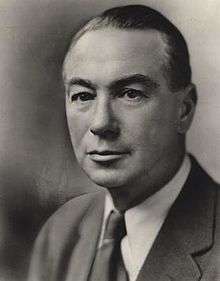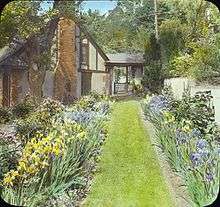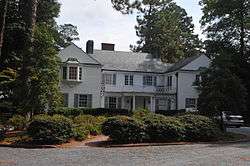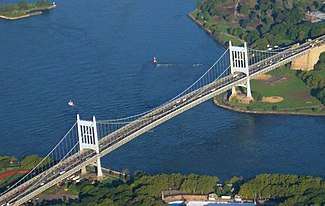Aymar Embury II
Aymar Embury II (June 15, 1880 – November 15, 1966) was an American architect. He is best known for commissions from the City of New York from the 1930s through to the 1950s. In this period, Embury frequently worked with Robert Moses in the latter's various city and state capacities, especially, early on, in Moses’ capacity as Parks Commissioner. Many surviving examples of Embury's work are zoos, swimming pools, playgrounds and other recreational structures in New York City parks.
Aymar Embury II | |
|---|---|
 | |
| Born | June 15, 1880 New York City, United States |
| Died | November 15, 1966 Southampton, Long Island, New York |
| Education | Princeton University |
| Occupation | Architect |
| Spouse(s) | Dorothy Coe, Ruth Dean, Josephine Bound, Jane Schabbehar |
| Children | Edward Coe Embury,[1] Carl Richard Embury,[1] Peter Aymar Embury, Mrs. Hugh Hack[1] |
| Parent(s) | Aymar Embury, Fannie Miller Bates |
Personal biography

Embury was born in New York City to Aymar Embury and Fannie Miller Bates.[1] Married four times, his first union was with Dorothy Coe in 1904.[1] However, they later divorced and he married Ruth Dean.[1] Dean was a famous landscape designer who designed Grey Gardens during the marriage. The two worked out of the same office but had separate shingles for their businesses.
A widower in 1932, he married Josephine Bound in 1934,[2] which ended in divorce.[3] He was survived by his fourth wife, Jane Schabbehar.[1] From the 1930s on, Embury maintained Manhattan and East Hampton, Long Island residences, and was active in East Hampton society.
Early professional career

Aymar Embury graduated from Princeton University in 1900 with a degree in Civil Engineering[1][4] and further received a Masters of Science degree in 1901. Following graduate studies, Embury taught architecture at Princeton[1] while also working for various firms in New York City, including Cass Gilbert, George B. Post, Howells & Stokes, and Palmer and Hornbostel. During this period he developed a keen interest in the architecture of small country houses, publishing several books and pamphlets on the subject. In 1905, Embury won both the first and second prize in a design contest sponsored by the Garden City Company for a modest country house in Garden City, Long Island. This gave him visibility as a "society architect"; he acquired a reputation as a builder of country houses for the upper middle class and received many further commissions for such houses in the years surrounding World War I.[5][6] He designed the James Boyd House, also known as Weymouth, at Southern Pines, North Carolina, and it was added to the National Register of Historic Places in 1977.[7]
Military career
Embury served for fourteen months during World War I as a captain in the Fortieth Engineers, United States Army Corps of Engineers[2][8] where he helped establish a unit of eight professional artists to document the activities of the American Expeditionary Force in France. During this time, Capt. Embury designed the Distinguished Service Cross and the Distinguished Service Medal.[9] Later, in 1932, he became a lieutenant colonel in the Officers Reserve Corps.[2]
Post war activities
By the late 1920s, Embury was well-known and had received a wide range of commissions all over the east coast of the United States, entailing college buildings and social clubs in addition to residences. He designed the Players and Nassau Clubs in Princeton, New Jersey, the Princeton Club of New York, the University Club in Washington, D.C.[5] and the Mountain Brook Country Club in Mountain Brook, Alabama[10] He designed the Hope Valley Country Club Clubhouse at Durham, North Carolina, in 1927.[11]
In 1930 he was appointed consulting architect by the Port of New York Authority[12] He consulted on the Authority's Inland Terminal.[13] As of the Authority's 1933 annual report, he was listed as Architect.[14]
Work with Robert Moses

In 1934, Mayor Fiorello La Guardia appointed Robert Moses as sole commissioner of a newly unified Department of Parks for New York City, commencing a seven-year period of construction and renovation of city parks. Embury, along with landscape architect Gilmore D. Clarke, was a senior member of an 1,800 strong design and construction team that Moses had assembled at the Arsenal in Central Park.[15]
In the following years, Embury was chief or consulting architect in numerous projects in the New York City area.[16] Exact figures are not available, but it is possible that Embury supervised the design of over six hundred public projects. Surviving examples include zoos such as the Central Park Zoo and Prospect Park Zoo; parks such as Bryant Park, Betsy Head Park, Crotona Park, Jacob Riis Park, McCarren Park, Red Hook Park, and Sunset Park; bridges including the Triborough Bridge and Henry Hudson Bridge;[17] and other features including the New York City Building at the 1939 New York World's Fair (now the Queens Museum),[18] Orchard Beach, Prospect Park Bandshell, and the Hofstra University Campus.[5]
Later work

In 1947, Embury designed the Dillon Gymnasium for Princeton University after the previous gymnasium was destroyed in a fire.[19] He remained active throughout the 1950s, turning over his firm to his son, Edward Coe Embury, in 1956. Remaining active as a consulting architect, Embury served on the architectural advisory committee for the old New York Coliseum at Columbus Circle; was a consulting architect for the New York Aquarium at Coney Island; designed the campus playhouse for Hofstra University in Hempstead, Long Island; designed the William Church Memorial Playground near Fifth Avenue; and designed the Donnell Library Center in Manhattan.[1]
Books by Aymar Embury II
- Embury, Aymar (1909). One Hundred Country Houses: Modern American Examples. The Century Company. p. 4.
One Hundred Country Houses.
- The Dutch Colonial House. McBride, Nast, and Company. 1913.
- Embury, Aymar (1914). Early American Churches. New York: Doubleday, Page, and Company.
Embury Country Houses.
- Day, Frank Miles; Howe, Samuel; Close, Bernard Wells; Sexton, Randolph Williams; Coffin, Lewis Augustus (1915). American Country Houses of Today.
- The Livable House: Its Plan and Design. New York: Moffat, Yard and Co. 1917.
- The Aesthetics of Engineering Construction.
References
- "AYMAR EMBURY, ARCHITECT, DEAD; Designer of Many Buildings and Bridges He Was 86". The New York Times. New York Times Company. November 15, 1966. p. 47. Retrieved May 11, 2007.
- "JOSEPHINE BOUND BECOMES A BRIDE; Daughter of Mrs. Alexander M. Orr Wed in Grace Church to Aymar Embury 2d". The New York Times. New York Times Company. September 18, 1934. p. 25. Retrieved May 11, 2007.
- "Mrs Embury Engaged. Former Josephine Bound is the Fiancee of Richard Millett". The New York Times. New York Times Company. August 16, 1948. p. 22. Retrieved May 11, 2007.
- "Firestone and the Post-War Building Boomlet". Retrieved December 23, 2006.
- New York Landmarks Preservation Commission (June 20, 2006). "ASTORIA PARK POOL AND PLAY CENTER" (PDF). LP- 2196. Retrieved December 24, 2006. Cite journal requires
|journal=(help) - "Aymar Embury II". Retrieved December 23, 2006.
- "National Register Information System". National Register of Historic Places. National Park Service. July 9, 2010.
- "U. S. Army Official War Artists". Archived from the original on December 5, 2006. Retrieved December 23, 2006.
- "US Army Decorations". Archived from the original on January 9, 2007. Retrieved December 24, 2006.
- "Southern Hospitality Expressed in The Mountain Brook Country Club at Birmingham, Alabama" (1931) Interior Decoration
- Cynthia de Miranda and Jennifer Martin (July 2009). "Hope Valley Historic District" (pdf). National Register of Historic Places – Nomination and Inventory. North Carolina State Historic Preservation Office. Retrieved November 1, 2014.
- "The Princeton Alumni Weekly, Volume 31". November 21, 1930. p. 233. Retrieved August 10, 2018.
- "Port of New York Authority, Eleventh Annual Report". Port Authority of New York and New Jersey. p. 4. Retrieved August 10, 2018.
- "Port of New York Authority, Thirteenth Annual Report". Port Authority of New York and New Jersey. p. 6. Retrieved August 10, 2018.
- "Robert Moses and the Modern Park System (1929–1965)". Retrieved December 23, 2006.
- Shattuck, Kathryn (August 14, 2006). "Big Chill of '36: Show Celebrates Giant Depression-Era Pools That Cool New York". The New York Times. Retrieved December 24, 2006.
- WPA Guide to New York City. 1982 [reprint of 1939 original]. p. 352.
- Zim, Larry; Lerner, Mel; Rolfes, Herbert (1988). The World of Tomorrow The 1939 New York World's Fair. The Main Street Press. p. 140. ISBN 0-06-015923-5.
- Leitch, Alexander (1978). A Princeton Companion. Princeton University Press.
External links
| Wikimedia Commons has media related to Aymar Embury II. |
- [Church, possibly early scheme for Winnetka (Ill.) Congregational Church] [graphic] : perspective rendering, ca. 1936. Held by the Department of Drawings & Archives, Avery Architectural & Fine Arts Library, Columbia University.
- "How to Build a House" by Aymar Embury II, in The Home of Beauty, American Face Brick Association, 1921, pp. 62-70.